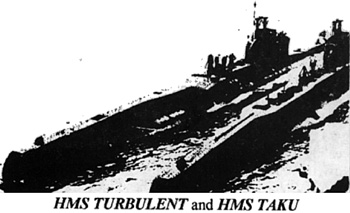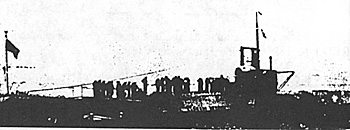(continued from KTB #111)
"T"-Class Submarines
TRITON launched in 1937; THETIS (later re-named THUNDERBOLT), TRIDENT, TRIBUNE, TRIUMPH and THISTLE all launched in 1938.
TAKU, TARPON, TIGRIS, TRIAD, TRUANT & TETRARCH launched in '39.
TUNA, TALISMAN, THRASHER and TORBAY all launched in 1940.
TEMPEST, THORN, TRAVELER, TRUSTY and TURBULENT launched '41.
TROOPER launched in 1942.
 HMS TURBULENT and HMS TAKU
HMS TURBULENT and HMS TAKU
SPECIFICATIONS - GROUP 1
Displacement......................1325/1580 tons
Dimensions.................274' x 26'6" x 16'4"
Compliment.....................................59 men
Propulsion..............twin shaft diesel/electric
Power (diesel)...................2,500 hp
Power (electric)..................1,450 hp
Fuel...............................................210 tons
Speed (diesel)..............15.25 knots
Speed (electric)..................9 knots
Range...................................9,510 N. miles
Depth of dive for:
Riveted hull boats............300 feet
Welded hull boats.............350 feet
Tubes.........................six 21 inch tubes fwd
Tubes..................two tubes external fwd
Tubes................two tubes on each beam
Guns...............................single 4" deck gun
During the Second World War, various military campaigns and battles have been individually described by numerous authors. The facts common to all of them, the over riding importance of controlling the sea and the supply routes upon which the success or failure of the contending armies depended. The contest revolved largely around the ability of the British to build up and reserve the little island of Malta as an offensive base in the midst of waters otherwise dominated by enemy air and sea power. This involved, on the one hand, supply and replenishment of the island fortress MALTA. On the other, the efforts by the enemy to eliminate it. On the outcome depended absolutely, the success or failure of the campaigns in North Africa and hence, it can be said on the whole war.
Although the title of this book is 'BRITISH SUBMARINES' I hope that the inclusion of other naval actions and situations will not be considered irrelevant. They are, in fact, part of my attempt to knit together the various operations to give a comprehensive survey of the war in the Mediterranean. Therefore to understand the important position which Malta held during the war, it is necessary that a narrative about Malta is first told.
At the crossroads of the Mediterranean, almost equal distance from Gibraltar on the one hand and Cyprus on the other, the small Maltese archipelago commands the trade routes not only between east and west, but also between north and south. Sicily lies sixty miles to the north and Tripoli in Africa is just over two hundred miles to the south. Gibraltar and Cyprus, or Port Said for the Suez Canal are each about a thousand miles away. The great siege of Malta in 1565 is one of the most famous in recorded history. Then, the Ottoman Empire under Suleiman the Magnificent, had attacked this outlying bastion of Christendom as a stepping stone to Sicily and Italy for the expansion of his empire into Europe. So famous had the island become after 1565 that the knights of St. John, the oldest order of Chivalry in existence and the third oldest religious order in Christendom, had become known throughout the world as the Knights of Malta. Over two centuries later, Napoleon seized the island in 1798 on his way to the conquest of Egypt and the East. Now Mussolini needed it, since this was the main sea route 'tween Italy & Sicily on the Italian colony of Tripolitania in the south.
This little island, Malta, in the middle of the Mediterranean, is only seventeen miles long and nine miles across its widest point. Malta's sister island Gozo lies across a narrow strait a few miles to the northwest and about half the size of Malta and without any similar harbours. In the channel between these two islands is the small island of Comino, inhabited by a few peasant families and there is an uninhabited islet, Cominoto. Just off the south coast of Malta is Filfla, another uninhabited island and there was yet another on the east coast, surmounted by a statue of St. Paul, marking the entrance to the Bay where the Apostle was reputed to have been shipwrecked and so bears his name.
Also, producing Malta's first Christian church leader, or Bishop in Pablius, the Head Man of the island, the Christian faith, by tradition at least, can thus be said to exist in Malta longer than almost anywhere else is the world.
Such was the totality of the Maltese archipelago upon which all the efforts of the Axis partners, Germany and Italy, attempted to neutralize it by siege.
Malta is like a slate upon which has been written and over-written the whole history of the Mediterranean. After the Romans came the Byzantines, and after them the Arabs, the latter in their two centuries of occupation left the most significant imprint of all, their language.
Finding a population who already spoke some old version of a semitic tongue, it was not difficult to impress their Islamic Arabic upon the Maltese whose modern language, despite all its borrowing from Italian, Spanish, French and English, is still an Arabic language in grammar and construction in all its basis words. The possession of this tongue, now recognizes as a distinct language, different to a degree from all others, has served throughout the centuries to give the Maltese a national character. It is this too, that has sustained them throughout all occupations and colonization; this and their attachment to the Catholic Church. Had Malta become a colony or dependency of Italy, the islanders Catholic faith surely would have blended with that of the Italians. There would have been more intermarriage, and the Maltese language and customs might well have been submerged. As it was, the islanders had a great affection for remote Britain, but had now developed a curiously deep hatred of their neighbors, the Italians.
People with whom, for centuries, their fishermen and merchantmen had shared the same sea, had violently attacked them. Many were intermarried. Many bore Sicilian and Italian names and of course, they shared the same Catholic faith.
Throughout the preWar years, the Italians had made great efforts through cultural and educational links with the Maltese. It was natural enough for geographic and mercantile reasons that Malta should feel a close affinity with Italy; added to which was the fact that Italian was the accepted cultural language among many of the upper classes. Until 1934 it had indeed been the language of the courts, with English or Maltese used as secondary languages but only about fifteen per cent of the population spoke Italian and almost none of the working class. So this anomaly was removed when it was decided that court proceedings must be conducted in Maltese, since it was the national language of the island and one which every Maltese speaks.
Malta possessed in its Grand Harbour and other ancillary harbours and anchorages, the finest fleet base in the Mediterranean. It could give secure refuge, watering and fueling facilities to the largest fleets in the world.
PORPOISE CLASS BOATS
 This class was intended to succeed the "M" Class. The periscope standards were offset vertically to starboard within the inner conning tower to allow a clear run for the mine-carrying railway which ran down the centerline from the inner bow to the outer stern doors. Compensating ballast was carried on the port side to ensure stability.
This class was intended to succeed the "M" Class. The periscope standards were offset vertically to starboard within the inner conning tower to allow a clear run for the mine-carrying railway which ran down the centerline from the inner bow to the outer stern doors. Compensating ballast was carried on the port side to ensure stability.
PORPOISE launched in 1932.
NARWHAL launched in 1936.
GRAMPUS and RORQUAL in 1936.
CACHALOT launched in 1937.
SEAL launched in 1938.
SPECIFICATIONS
Displacement......................1520/2157 tons
Dimensions.................289' x 25'6" x 15'6" (PORPOISE was 288' x 30' x 14')
Compliment............................................59
Propulsion..............twin shaft diesel/electric
Power (diesel).................3,300 bhp
Power (electric)...............1,630 bhp
Speed (diesel).............................15 knots
Speed (electric)............................9 knots
Range.....................7,500 miles @ 10 knots
Tubes..................................six 21 inch fwd
Guns........................single 4" deck gun fwd
Mines......................................................50
More Royal Navy
-
Submarines Sunk and the HMS Sealion
Mediterranean Campaign June 1940-July 1941
"T"- and "Porpoise"-Class Submarines
Malta
Italy Bombs Malta 1940
British Strategy Mediterranean 1940
British Parthian
Back to KTB #112 Table of Contents
Back to KTB List of Issues
Back to MagWeb Master Magazine List
© Copyright 1999 by Harry Cooper, Sharkhunters International, Inc.
This article appears in MagWeb (Magazine Web) on the Internet World Wide Web. Other military history articles and gaming articles are available at http://www.magweb.com
Sharkhunters International, Inc., PO Box 1539, Hernando, FL 34442, ph: 352-637-2917, fax: 352-637-6289, e-m: sharkhunters@hitter.net
